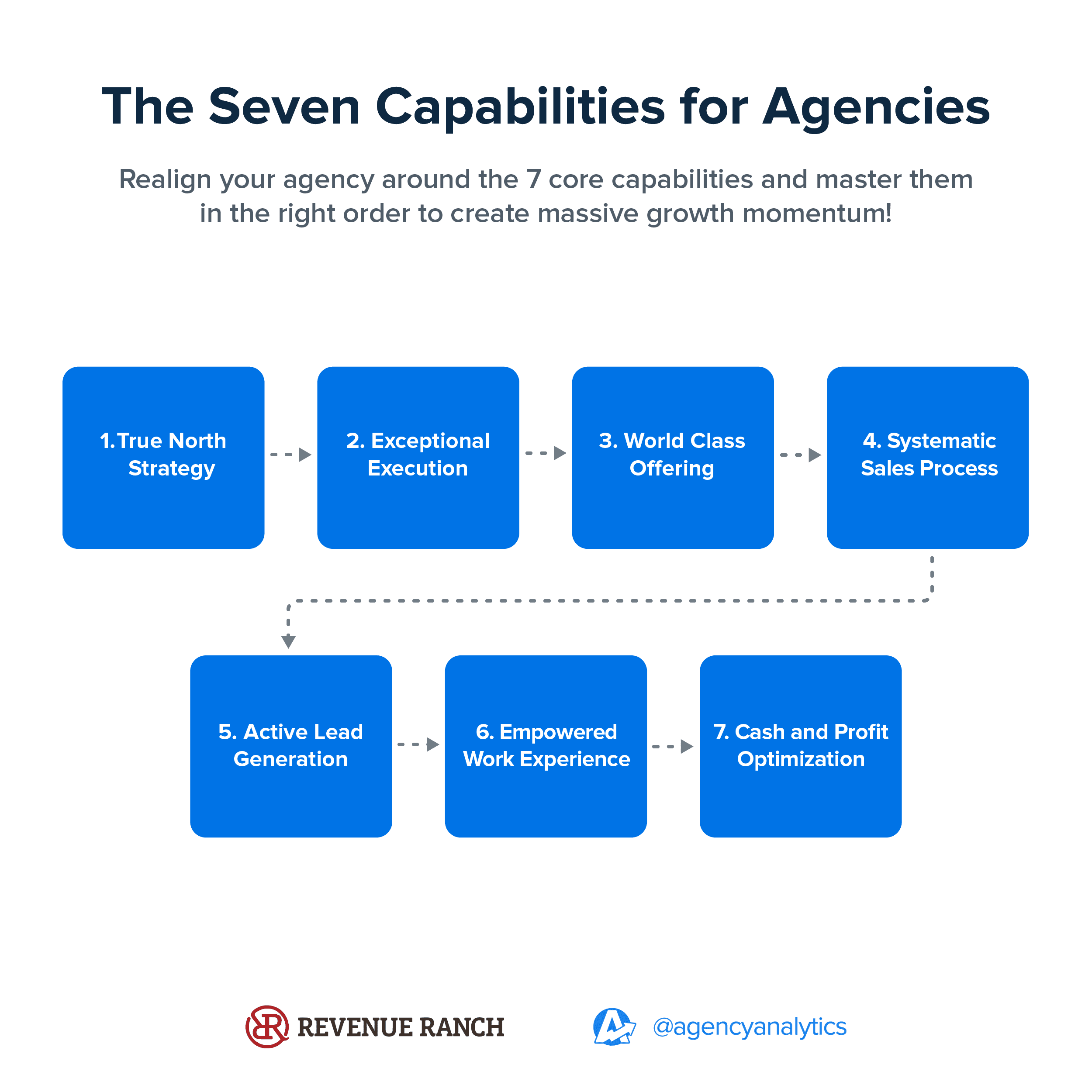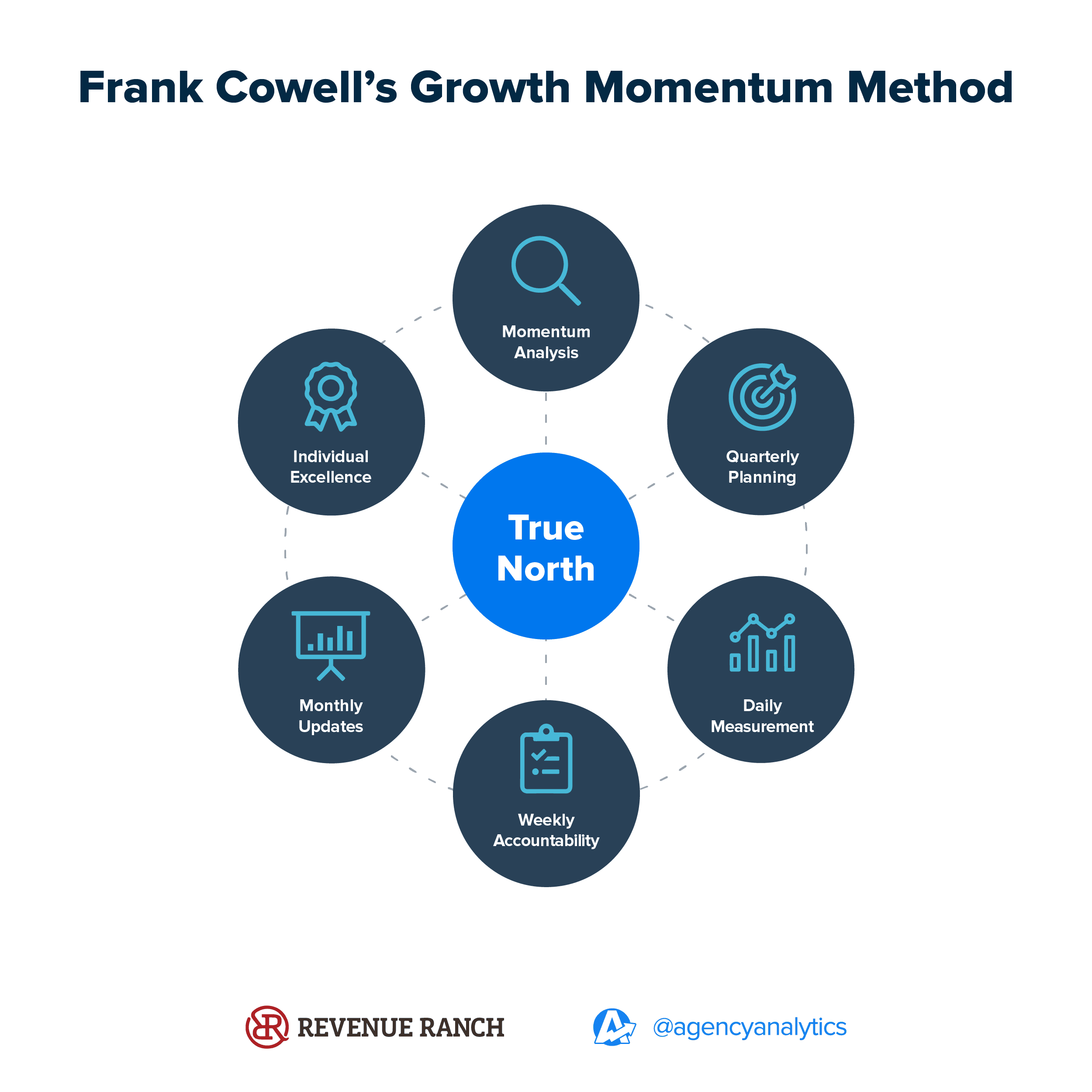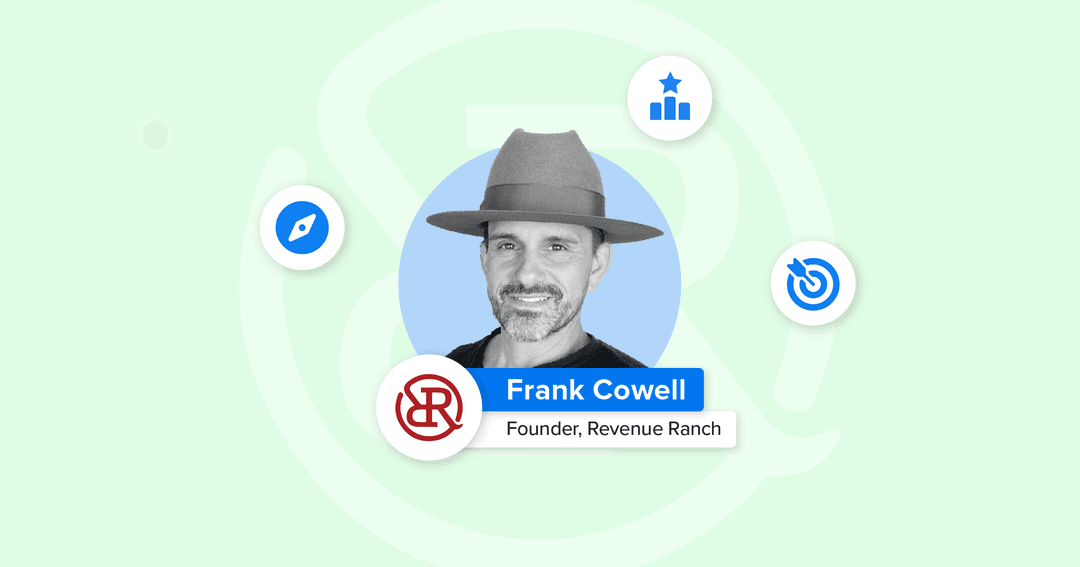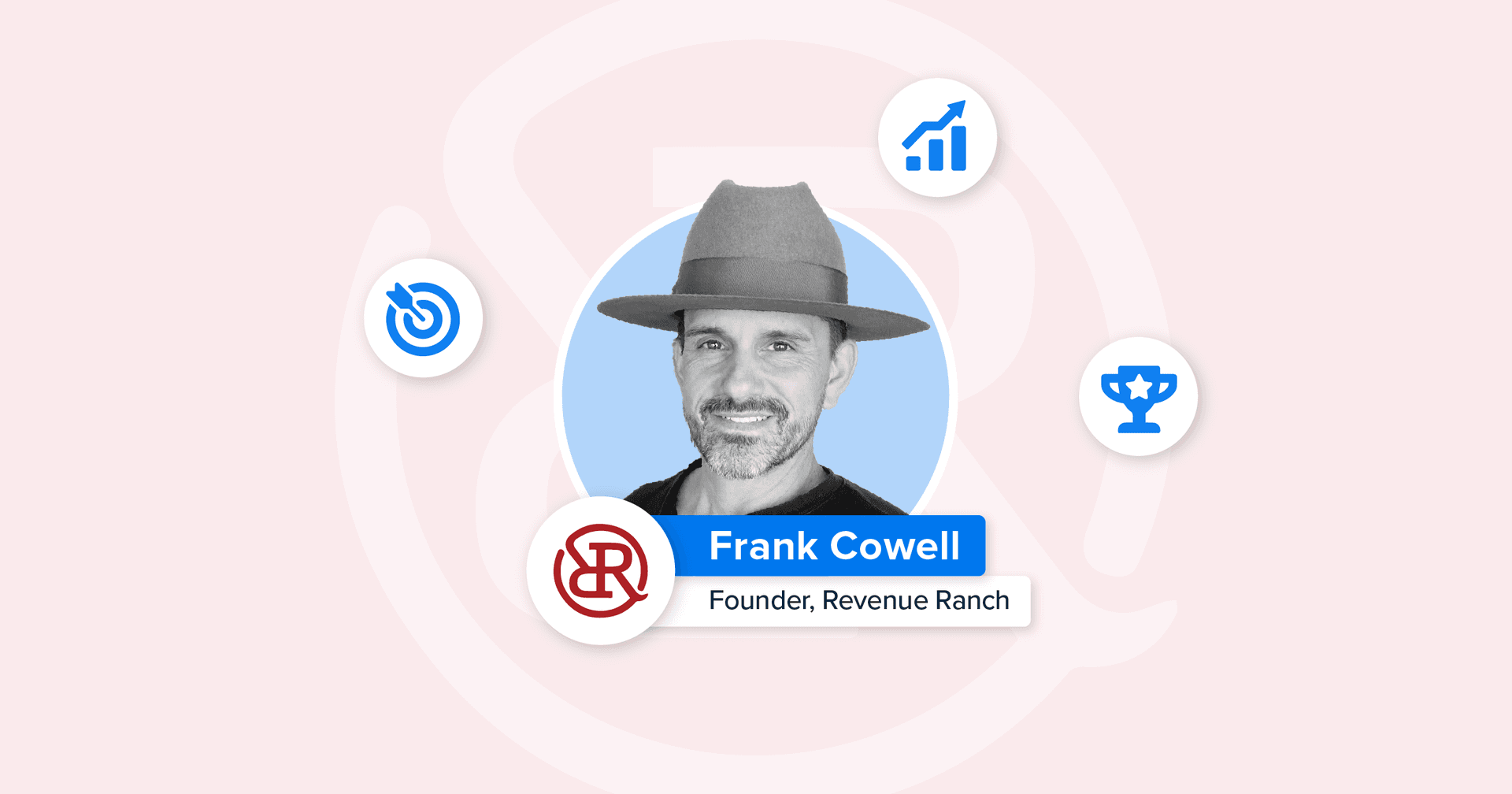Table of Contents
Table of Contents
- What Is a True North Strategy?
- Why Agency Transformation Is Achieved Through True North
- Understanding the Components of True North for Agencies
- What Is the Agency Leader’s Role in True North Strategy?
- How to Operationalize True North Strategy for Agencies
- What Are the Long-Term Implications of True North for Agencies?
- Setting the Stage for Exceptional Execution
7,000+ agencies have ditched manual reports. You can too.
Free 14-Day TrialQUICK SUMMARY: Crafting a True North Strategy transforms agency leadership and aligns your team toward a unified vision. In this article, Revenue Ranch founder Frank Cowell explores the importance of setting clear strategic directions, the long-term benefits of True North, and practical steps for integrating this approach into your agency’s operations to drive success and foster sustainable growth.
An agency leader without a clear direction is like a hiker without a trail marker: prone to wandering aimlessly and losing valuable time. Establishing a True North Strategy means having clear signposts and trail markers, ensuring the organization stays on the path to achieving its strategic objectives.
As the trusted sherpa in our ascent up the agency hill, Frank Cowell previously laid out his Seven Capabilities framework, which is essential for any agency's success.

The first of these capabilities is the True North Strategy—the magnetic pole on your agency’s compass. By defining a clear and compelling direction, this strategy helps ensure that every part of your agency—from the smallest tasks to the biggest goals—lines up with a central, cohesive vision.
Why is this so important? Having a solid direction keeps your agency’s execution on track—it influences your strategies, shapes your agency culture, defines your approach to projects, and even guides your interactions with clients.
Your business strategy needs to be the True North for all other decision-making, whether at a macro or micro level.
Frank Cowell, Founder, Revenue Ranch
The True North Strategy is the cornerstone for building a successful agency. It guides everything you do toward a common goal.
Let’s explore how Frank Cowell details this strategy and how it will change how your agency moves forward and upward.
What Is a True North Strategy?
Embodied by the CEO, owner, or agency founder, a True North Strategy sets a clear, unwavering direction that governs all aspects of an agency’s operations. It integrates core elements such as vision, mission, values, and the agency’s value proposition into a cohesive strategy that all team members will follow.
The goal is to establish something clear and compelling and then build an aligned and driven team of professionals who are all pointed in that direction.
Frank Cowell, Founder, Revenue Ranch
Adopting a True North Strategy from the start provides a clear path to success and guides the agency’s growth and adaptation. It ensures that all parts of the organization are harmoniously aligned toward achieving the set objectives and creates consistency in decision-making, which fosters a strong, unified agency culture.
However, Frank acknowledges that it may need refinement as the agency evolves and learns more about its market and capabilities—especially in the early stages of the agency. This allows agencies to remain responsive to new information and changing conditions without losing sight of their fundamental goals.
Why Agency Transformation Is Achieved Through True North
Frank emphasizes the need for agencies to move beyond just selling services to creating real change for their clients. He argues that the core of an agency’s strategy, the True North, shouldn't just focus on what products or services are offered. Instead, it should aim to solve big problems in the market and provide transformative results.
You may not be this unicorn in the marketplace, but when you apply that service in a differentiated way and back that up with transformational value propositions, you become the only game in town.
Franck Cowell, Founder, Revenue Ranch
This means shifting the focus from what the agency does to how it significantly improves a client’s business, making the agency an essential partner in their growth rather than just another service provider.
One example Frank shares is of a firm that shifted its focus to specialize in one area where it could make a significant impact. Originally working with a broad client base, the firm chose to focus on one sector, greatly improving its offerings and becoming the top choice in that niche. This shift from general services to specialized transformation helped them stand out and become recognized as industry leaders.
Some might say, ‘Frank, this is just as simple as niching down and just picking a vertical.’ I would say that it’s a step toward defining your True North strategy. The other steps are uniquely understanding the Number One thing they want to accomplish relative to what you're capable of bringing and defining the kind of transformation you aim to create.
Frank Cowell, Founder, Revenue Ranch
Understanding the Components of True North for Agencies
When constructing a True North Strategy, there are several core components every agency needs to consider. These components—vision, mission, values, value proposition, and boulder—serve as the pillars that support and guide every strategic decision and initiative within the agency.
As Frank explains, the idea behind True North is more than a guiding principle; it’s a path to business transformation.
Let's delve into each of these components:
Vision
The vision of an agency is a forward-looking statement that outlines what the agency aspires to achieve in the long run. It’s the ultimate goal the agency strives for, often encompassing a broader impact than immediate business targets.
Mission
While the vision is future-oriented, the mission focuses on the present; it defines the agency’s purpose and its primary objectives. The mission statement clarifies what the agency does, whom it serves, and how it differentiates itself in the marketplace.
Values
Values are the fundamental beliefs and principles that guide an agency’s culture and behaviors. They articulate the agency's ethical stance and influence how it interacts with clients, employees, and other stakeholders.
Brand
In the context of a True North Strategy, Brand embodies the entire narrative of the agency.
Frank says the brand should communicate the total value of the agency through a story-like structure—“a manifesto, if you will.” This narrative encapsulates what the agency does, how it operates, why it exists in the market, and what makes it distinct from competitors.
An agency brand manifesto should also have the following supporting components:
Condensed Value Proposition: A concise version of the agency’s story or value proposition, tailored for quick understanding on the agency's homepage.
Essential Answers: Succinct responses to crucial questions like "What do you do?" and "How do you do it?" which articulate the agency's purpose and methodology.
Personality: The distinctive character of the brand influencing how messages are conveyed and perceived by the audience.
Key Messaging: Fundamental points that are consistently communicated across all platforms to reinforce the agency's values and strategic objectives.
Boulder
You’ve likely heard of EOS rocks. In a way, the Boulder is the single biggest “rock”—the most important achievement that will move you closer to your vision in the next 12 to 36 months. The boulder is often set as an internal goal rather than an external objective.
As such, it won't complete in 90 days the way rocks should. This Boulder is the one big strategic imperative that the agency must accomplish in the next 1-3 years. It's critical that the person in charge of True North Strategy (aka CEO) defines this, owns this, and ensures the team understands why it's important to the overall Vision and Mission of the company.
Once a firm has the Seven Capabilities established consistently, the Boulder is often external or expansion focused—launching a new division, acquiring another firm, etc.
Frank Cowell, Founder, Revenue Ranch
This component helps prioritize resources and focus the team's efforts on achieving a significant milestone that directly contributes to the realization of the overall Vision.
An example of a Boulder might be "to develop and launch an AI-powered analytics platform by Q3 2025, aimed at doubling the campaign effectiveness for our clients."
What Is the Agency Leader’s Role in True North Strategy?
The agency leader (i.e., CEO, founder, or owner) plays a critical role in shaping and steering the agency according to the True North Strategy.
The leader’s job involves much more than managing day-to-day activities; it's about setting a clear direction that everyone in the organization will follow.
1. Defining the True North
The first task for any leader is to clearly define the True North. This means deciding what the agency’s main goals (vision), daily purpose (mission), core principles (values), and unique strengths (value proposition) are.
Although the leader gathers lots of input and data to make these decisions, in the end, they are responsible for making the final call on what the True North should be.
Frank asks his clients to go through what he calls an "inventory exercise." He presents his founder clients with a comprehensive questionnaire, and he wants to hear how everyone on the team answers these inventory questions:
Why did you start the firm?
What are you personally really great at?
What is your firm great at?
What is your firm terrible at?
Who are you really great at serving?
If you could wave a magic wand, what would you be doing in the business?
If you could wave a magic wand, what would the business look like?
As a founder, if you answer these kinds of reflective questions and it's just you answering, you're gonna continue to live in your own bubble. You become your own echo chamber.
Frank Cowell, Founder, Revenue Ranch
2. Upholding the True North
Once the True North is set, the leader must ensure it remains relevant and adhered to across all parts of the agency. This involves integrating these principles into everything from hiring new staff to how projects are run and how the agency markets itself.
Leaders must also perform a momentum analysis to regularly check that these elements are followed and are the driving force behind every action the agency takes.
3. Ensuring Strategic Alignment
It’s crucial for leaders to make sure every decision and action supports the agency’s overall True North direction. This means being selective about new opportunities—service expansion, new clients, niche opportunities, etc.—and always asking whether they fit with the long-term vision and values of the agency.
Leaders also need to ensure everyone in the agency understands and works towards these common goals, which requires consistent communication and reinforcement with staff and clients.
4. Communicating and Living the True North
Leaders must be great communicators, constantly reinforcing the agency’s core goals and how everyone contributes. They must also lead by example through individual excellence, embodying the agency’s values and vision in their everyday actions and decisions. This helps maintain internal morale and focus and enhance the agency’s reputation externally.
True North sits at the middle of your cyclical planning and management activities. As such, planning and management always align to True North Strategy. The collection of these planning and management activities are called Exceptional Execution and they repeat in quarterly cycles.
The totality of this strategy and execution framework is called the Growth Momentum Method.
Frank Cowell, Founder, Revenue Ranch

How to Operationalize True North Strategy for Agencies
Integrating the True North strategy into an agency's daily operations and decision-making processes is crucial for maintaining strategic alignment and ensuring that every team member contributes to the organization's overarching goals.
Here’s a breakdown of how to effectively embed this strategy within the agency’s operations:
Embedding True North in the Agency’s Daily Operations
Frank is quick to point out that True North encompasses only a fraction of the agency’s actual work. Once the True North is set, the focus must shift to “exceptional execution,” which is the most important element of his Seven Capabilities Framework (more on that in our next article with Frank).
For an agency to focus on execution, the following elements must match to the organization’s True North:
Clear Communication
The first step is to communicate the True North clearly and frequently across the organization. This means regularly discussing the vision, mission, values, value proposition, and Boulder in team meetings, training sessions, and in internal communications. It should be clear to every employee how their work directly contributes to these larger goals.
Strategic Decision-Making Tools
Incorporate the True North into all decision-making tools and processes. For example, when evaluating new projects, leaders should use criteria based on the True North elements to assess potential opportunities.
Decision-making frameworks should include questions like,
Does this project align with our mission?
Will this initiative bring us closer to our Boulder?
Is this in line with our core values?
Performance Metrics
Align performance metrics and agency KPIs with the True North. This involves setting individual and departmental goals that are directly linked to achieving aspects of the True North.
For instance, if part of the agency’s mission is to enhance customer engagement, metrics could include measures of customer satisfaction, engagement rates, and feedback scores.

Forget manual reporting: Build a customizable dashboard in seconds using AgencyAnalytics to track user engagement across client campaigns. Try it free today!
Aligning True North Across All Agency Departments
Ensuring that every team, from creative to finance, understands and integrates this strategy will transform disparate efforts into a cohesive force driving the agency forward.
Let's explore how alignment across departments amplifies the effectiveness of the True North Strategy and foster a unified agency culture.
Sharing a Unified Vision Across Departments
Ensure that all departments understand how they fit into the bigger picture. This might mean customizing the message of the True North so it resonates with different areas, from creative to tech to sales.
For example, the tech team could focus on how their work on data security supports the value of client confidentiality, while the marketing team might concentrate on how their campaigns drive the vision of becoming industry leaders.
Focusing on Consistent Training and Development
Regular training sessions that reinforce the True North principles help maintain alignment. These sessions address how the True North relates to various roles within the company and update the team on any shifts or progress toward the Boulder.
Implementing Inclusive Strategy Reviews
Involve different departments in strategic reviews. Regularly scheduled review sessions where teams present how their projects and initiatives are aligning with the True North encourage cross-departmental understanding and collaboration. This also helps in identifying any misalignments or areas where the True North needs to be more deeply integrated.
Modeling the Agency Through Leadership
Leaders at all levels should model the behaviors and attitudes that reflect the True North as a powerful example for all employees. This is particularly impactful in how leaders handle challenges and opportunities, showing the team practical applications of the True North in their decision-making.
What Are the Long-Term Implications of True North for Agencies?
Implementing a True North strategy has profound implications for the long-term success and sustainability of an agency. It's a strategic foundation that guides current operations and shapes the agency’s future trajectory.
Sustaining the Agency’s Long-Term Vision
As the agency evolves, leaders must regularly reinforce and recalibrate the True North to ensure that every team member remains committed to the agency's core objectives. This involves regular communication, training, and leadership engagement to keep True North relevant and top of mind.
As markets change and the agency grows, the True North may need to evolve. Strategies to adapt the True North include:
Regular Strategic Reviews: Holding periodic reviews (weekly and quarterly) to assess the relevance of True North in the current market context and making adjustments as necessary.
Feedback Mechanisms: Implementing systems to gather feedback from employees, clients, and market trends to inform adjustments to the True North.
Innovation Focus: Encouraging innovation within the agency to explore new ideas and opportunities that align with the long-term vision and adapt to current market needs.
Planning Succession When Leaders Choose To Step Back
A critical aspect of True North strategy is planning for leadership transitions without losing the strategic focus. When a leader decides to take a step back from execution, transition considerations include:
Identifying Potential Leaders Early: Recognizing and nurturing potential leaders within the agency who embody the True North and will sustain its vision.
Leadership Development Programs: Creating structured programs to prepare future leaders to take over, with a strong emphasis on understanding and leading according to the True North.
Gradual Transition Processes: Ensuring a smooth transition by gradually transferring responsibilities, allowing outgoing leaders to mentor incoming ones to uphold the integrity of the True North.
That said, when a founder or CEO decides to reduce their day-to-day involvement, their role may still significantly impact the agency’s adherence to the True North. During this time, the leader could transition into a new role, including:
Strategic Advisor: The founder continues to serve as a strategic advisor, focusing on big-picture strategies and ensuring the True North remains a guiding force.
Board Member: Transitioning to a board member role allows the founder to oversee the agency’s strategic direction without daily operational involvement.
Brand Ambassador: The founder may also serve as a brand ambassador, representing the agency’s values and vision in public appearances, continuing to promote and reinforce the True North externally.
If the founder wants to move on, the first natural step would be to hire a president or a GM— whatever you want to call that job title—to head up exceptional execution. Then you stay around as a CEO to make sure the process is running as smoothly as it was under your leadership.
I think any founder that's going to remain “in” at that level, though, has to provide more tangible value than only wearing the CEO hat.
Frank Cowell, Founder, Revenue Ranch
Setting the Stage for Exceptional Execution
A well-defined and executed True North Strategy will significantly enhance an agency's resilience and adaptability. It ensures that every aspect of the agency—from its core services to its market positioning and internal culture—is aligned towards a common goal and drives exceptional execution, responding to changes, seizing new opportunities, and navigating challenges effectively.
You have to make sure you're always looking through the lens of True North. Think about a globe: If North is on top, everything around it is gonna point up there. Execution is the way you make sure that you maintain that team of aligned and driven professionals.
That process alone does the bulk of the work to keep you aligned to True North. If you just do that part and implement the protocols into your business for planning and managing the plan and how you empower individuals, you'll get 80-90% of everything taken care of.
Frank Cowell, Founder, Revenue Ranch
By embracing a True North Strategy, agencies achieve a level of strategic clarity that permeates every layer of their organization. It transforms their approach to business and client engagement—pushing the agency beyond achieving short-term goals and, instead, building an enduring legacy of success.

Written by
Francois Marchand brings more than 20 years of experience in marketing, journalism, and content production. His goal is to equip agency leaders with innovative strategies and actionable advice to succeed in digital marketing, SaaS, and ecommerce.
Read more posts by Francois MarchandSee how 7,000+ marketing agencies help clients win
Free 14-day trial. No credit card required.





